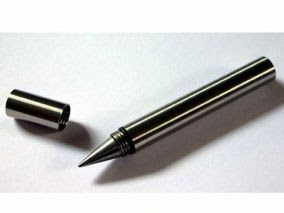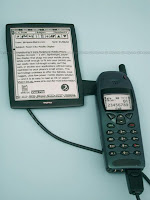
Merging the mobile and computer with the humble pen
Efforts to combine the sheer convenience of the pen as an input device with the benefits of digital technology continue to evolve with Livescribe's launch of the Pulse Smartpen. Based on licensed technology from pioneering digital pen developer Anoto, the Pulse is a computer in the shape of a pen that not only digitally captures handwriting, but simultaneously records audio and synchronizes it to the writing. Working in conjunction with a special Dot Paper Notebook, the system promises incredible benefits for students, professionals or anyone in a note taking situation... and that's just the beginning. By simply tapping the pen on the paper, the system will replay audio coinciding with the moment those notes were taken and using navigation controls printed on the bottom of each page, users can fast forward, rewind, jump ahead, pause, and even speed up or slow down their audio recordings. In short - everything you hear, speak or write is captured by the Pulse.
"Pulse is a new type of mobile computer that supports the four basic modes of human communication – reading, writing, speaking and listening," said Livescribe, Inc. Founder and Chief Executive Officer Jim Marggraff. "Using an embedded speaker and display for audio/visual input, and microphones and a pen for audio/visual output, Pulse advances the power and flexibility of mobile computing – it's the missing link that now connects the paper and digital worlds."

The Pulse Smartpen will be available in two models. The 1GB model (USD$149) that provides storage for around 100 hours of recorded audio, 16,000 pages of digital notes or add-on applications while the 2GB (USD$199) provides more flexibility for downloading future applications.
Housed in anodized aluminum, the Pulse Smartpen weighs 1.3 ounces (36 grams) and measures 6.1 inches (155mm). The device features a Samsung ARM 9 (32-bit, 150 MHz) processo,r high speed infrared camera (over 70 images per second) incorporating Dot Positioning System (DPS) technology, a rechargeable lithium battery, a high contrast 96x18 OLED display, dual microphones with noise cancellation and an embedded speaker and an audio jack for Livescribe's 3D Recording Headset, itself optimized for capturing audio in noisy environments.

Recharging and transfer of data to computer is via a light weight USB Mobile Charging Cradle and the included Desktop Software allows storage, replay, and searching for words within handwritten notes after they are transferred to PC. The package will also give users access to the Livescribe Online Community which includes 250MB of online storage to upload and share notes and audio as interactive Flash movies or PDF files.
The Dot Paper Notebook works via a series of nearly-invisible micro dots printed each page that communicate with the smartpen so that it knows where you are writing or tapping. TIn addition to the navigation functionality this allows, the Dot Positioning System also facilitates a full-function calculator on the inside front cover of every notebook. According to Livescribe, additional notebooks will be comparable in price to ordinary paper notebooks and from April, the technology will become available on qualified laser jet printers so that you can print your own Dot Paper.

Coinciding with the launch, Livescribe has also announced a Developer Program inviting developers to build innovative, paper-based computing applications for the Pulse smart pen. Examples of applications already in progress include foreign language translators, productivity tools, games, interactive books, transcription services, and specialized educational aids like applications to assist visually-impaired students.
The applications for this technology seem only limited by the imagination. One interesting example already in development through Audio Tutor is an interactive birding journal that provides visuals and information in both text and audio and lets users record their birding expeditions through handwriting, drawings and audio recordings.
 The new 'Morph' concept phone:
The new 'Morph' concept phone:


















































